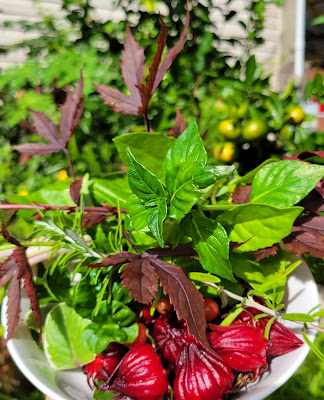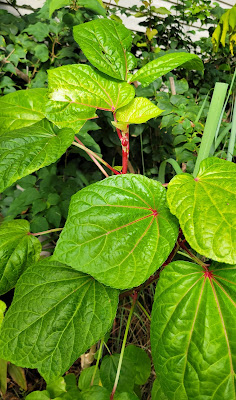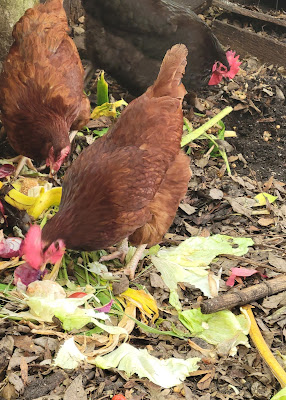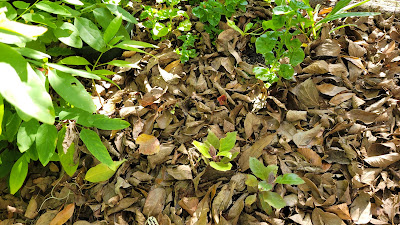- Get link
- X
- Other Apps
- Get link
- X
- Other Apps
 |
| A daily harvest from the neglected garden |
Finding time for gardening is difficult, but you can have a garden even when you're busy. My youngest son started pre-k three days a week this past August, and for the first time in many years, I now have some time without kids. I had so many projects in the garden awaiting all of this time I would have. Of course, the time has vanished, one hour after another, and my garden is more neglected than ever.
 |
| Our South Sea Salad tree is thriving in the garden despite the neglect. |
The neglected garden provides loads of food for us and for our pets despite the lack of care, but it is thanks to the permaculture principles and natural gardening ways that it demands less time than other gardens.
Gardening Tips for the Busy Gardener:
- Use compost
- Have a compost pile instead of a bin
- Stay on top of pruning by composting in place.
- Don't use pesticides and chemicals
- Create a pollinator-friendly garden.
- Plant in the ground or in big containers
- Use natural weed-preventing strategies
- Use shade to your benefit
- Pick and prune strategically
- Create propagation Stations
- Use permaculture and food forest strategies
Gardening when you're busy is difficult, but if you use the busy-garden strategies above, which are actually just sound gardening concepts, then you'll be much better off if you get busy, and the garden gets neglected.
Easy Gardening Tips:
Use Compost
Compost is my main fertilizer. In fact, I haven't fertilized anything since the early spring, but every few months I'll bring a bucket around full of compost, and compost makes the garden flourish. When the soil is healthy, full of microorganisms and nutrients, the plants will hold up much better in times of neglect or drought.
Compost Pile vs. Compost Bin
A compost bin needs to be rotated or turned. A compost pile does the work itself, worms and critters dig through it, or in our instance the chickens do the work. We have a compost pile in the chicken coop, where everything gets dumped. The chickens pick through and take what they want, mixing it all up, and sometimes they even add some fertilizer.
 |
| Composting tip: make your composting pile in the chicken coop. |
When the leaves drop, we pile them up and the chickens go through them, pecking at them, and again mixing it with greens. It's the best kind of compost, and whenever we need some, we just go and get a bucket from the chicken coop.
Compost in Place
Composting in place is something banana growers are used to doing. Bananas need to be fed often, and banana leaves work wonders. When I'm in the garden, most of what I prune goes to the foot of the banana trees or other plants, while some end up as chicken feed.
Don't Use Pesticides and Chemicals in the Garden
If you don't use pesticides and chemicals of any type in your garden, your garden will create its own natural defenses. Beneficial bugs such as ladybugs and butterflies will take over, and many of the pests we abhor will be in limited numbers because of the beneficial bugs. Yes, you will see insect damage, but look at your garden as being healthy and chemical-free, and you will soon forget about the few insect-ridden leaves.
Create A Pollinator-Friendly Garden
Creating a pollinator-friendly garden goes hand-in-hand with not using pesticides and chemicals in the garden. When I do go in the garden to pick food for dinner or fruits from the trees, butterflies and bees buzz around me, hummingbirds flutter about as if I wasn't even there, and not only is it helping the environment, but it helps fruit production as well.
 |
| Gardening Tips: using ground covers for weed prevention |
Plant in the Ground or in Big Pots
Planting in the ground is the best thing you can do for your plants if you don't have much time. Potted plants need frequent watering, as the pots dry out fast. I have some plants in the ground, but because our home is temporary and our plants are awaiting their permanent growing spot, most of my plants are in pots. At our growing food forest at the land, I barely ever have to water, because the plants and fruit trees manage all by themselves, their roots stretching down below until they find water.
I try to source the biggest pots I can find, and then I create environments in the pots beneficial for the plants and trees, and I create an environment that helps the plants withstand the hot Florida sun.
Last week I replanted two everbearing mulberry trees, using leaves and sticks from the garden mixed with compost and composting woodchips as a base. I planted sweet potato slips at the base of one mulberry, and at the other pot I am propagating things such as cranberry hibiscus, and I've planted collard greens and lettuce as well to create a groundcover of sorts.
When you have a groundcover around your fruit trees, whether they're in the ground or in big pots, you help prevent the sun from drying out the topsoil, and you keep the soil in place when it rains hard. I mainly use Cuban oregano, sweet potato slips, mushroom herb, and sissoo spinach but any plant that's not deep-rooted will do, and herbs, lettuces, and collard greens are a great way to grow more food in a small space.
Use Natural Weed-Preventing Strategies
Not only is weeding time-consuming, but it is also back-breaking work, and I don't recommend weeding to anyone over 40. This summer, I actually ended up with a backache for two weeks after a weeding incident. So no, I prefer not to weed. Of course, weeds are a part of gardening, but if you want to garden with little time available, weeding should be done strategically.
For natural weed control, I swear by woodchips, leaves, and ground covers. Woodchips are great at choking out weeds, but they also provide great soil. Right now, the leaves are falling all over my garden, and they prevent a lot of weeds from popping up.
 |
| Gardening Tips: using leaves to prevent weeds |
My favorite natural-weed control is the use of ground covers. Yes, sweet potato vines will take over the ground, so will Cuban oregano, and if you're lucky mushroom herb, sissoo spinach, and longevity spinach will multiply. If you're in a cooler growing zone, you might want to look into other options, but there are ground covers for every growing zone, and these will help prevent weeds.
Use Shade as a Gardening Resource
It might take a little while, and you might need to give it a few tries, but once you find the right location for the right plant, you won't need to do much about it. I have certain plants that don't do well in the hot, Florida summer, these I place where they will get shade during the midday and afternoon hours where the sun can be scorching.
Banana plants, papayas, Mexican sunflowers, pigeon peas and moringa are a few of the fast-growing plants I use for shade during the summer. Not only for our southern-facing windows, but I also put plants on the north and west side of these fast-growing plants to give them summer shade. Growing Sweet potato vines and grapes over a pergola or trellis arbor can also help shield plants such as strawberries in the hot summer sun, while these vines die down in the cooler months, where strawberries thrive here in Florida.
 |
| Cuttings turning into new plants. |
Pick and Prune Strategically
In our garden, nothing goes to waste. If I'm pruning a fruit tree, I have a container with sand and growing powder ready for propagation. In one of my southern windows, I have created a propagation station, consisting of an under-the-bed type, low plastic bin. Every week or so, I'll fill up a new container (quart yogurt containers work great) with sterile soil. Don't put any holes in it. Whenever I bring in leafy greens for cooking such as Okinawa spinach, sissoo spinach and Hoan Ngoc, I cut the stem of the plant, just above two leaves. Inside, I'll pick off most of the leaves for cooking, leaving a few leaves at the top. Then I'll propagate the stem making more plants. You can find easy instructions for plant propagation here.
Outside, there are certain plants such as Cranberry Hibiscus, Chaya, Longevity Spinach, and Mexican Sunflowers, which do not even need any growing powder. For Cranberry Hibiscus, I cut off a big branch right above two leaves. I strip the leaves and use them for cooking, the rest of the stick gets put in whatever pot has a free spot, and in a few weeks, it will have rooted, and I will now have more food for my family or the chickens.
You can also check out the plastic bin propagation method here. This is how I propagate many plants outside without having to worry much about the cuttings.
These are some of the gardening tips that I swear by. They ensure that even when I'm busy, the garden can maintain itself, and as you can see the neglected garden still provides when you take a few preventative steps to keep it healthy.
It's not that I haven't been spending time in the garden. I usually get a couple of hours each week, but my time in the garden is project-based. Last week, someone dropped off 4 loads of woodchips at the community compost pile, and what a blessing it was. It took a lot of work moving woodchips, but it was so worth it.
The start of school for our youngest child also meant the beginning of a new chapter for me. For the past many years, I have been writing several novels awaiting this time, and now I'm getting ready to start seeking an agent and a publisher. That's one of the main reasons why my garden has been neglected.
Of course, I'm also an organizer, and the past many months have been busy with organizing fundraising campaigns, social media campaigns, organizing events, etc. If you're interested in seeing some of the things I do besides gardening, you can check out my author website SineBoe.com. You can also see what other things this busy gardener is up to here.
Do you have any gardening tips to share?
Follow Dancing Treetops on Facebook, Dancing Treetops on Instagram, and subscribe on YouTube.
Busy Gardener
Composting
Composting Tips
Easy Gardening
Florida Food Forest
Food Forest Tips
Garden Tips
Gardening Tips
Permaculture
Permaculture Tips
- Get link
- X
- Other Apps
Popular Posts
Troy-Bilt Wood Chipper - Super Tomahawk = Our No. 1 Tool For Better Composting
We could not have gotten as far with our sustainable land clearing and composting, if it had not been for our power horse, our Troy-Bilt Super Tomahawk wood chipper with its 8 HP Briggs & Stratton motor. We purchased this 31+ year-old wood chipper off Craigslist for $200 about a year and a half ago, and it is still going strong. Troy-Bilt Super Tomahawk Wood Chipper
Zone 9A/9B Gardening Calendar - North East Florida Planting Schedule
Gardening in Florida is a very different experience than gardening in the rest of the country, and growing fruits and vegetables in North East Florida is a very different experience than gardening down south. It has taken us about five years to adjust to the zone 9 planting schedule, and while there are many zone 9 garden guides out there, we felt that there was a need for a simple, user friendly zone 9A/9B planting calendar.
How To Remove Palmetto Palms
If you have ever tried to remove a palmetto palm by cutting it down, you will likely have realized that removing palmettos is tricky. So, when we got ourselves a piece of land with about half an acre of these wonderful palmetto palms, also known as saw palmettos or shrub palmettos, we knew that we had a challenge on our hand.
Where To Find Free Nursery Pots and Planters
Every gardener needs something for their plants to grow in. Whether it is directly into the soil in your garden, into a garden bed, nursery pots, ceramic pots, terracotta pots, or if you get more creative, you need something for your plants to grow in. That's why we're always looking for free nursery pots and cheap planters.
How to Transplant a Banana Tree
Wondering how to transplant a banana tree? I know, it's not a tree, so wondering how to move a banana plant? Bananas are pretty easy to move, and they're pretty hardy too. The best time to transplant a banana plant is in the rain season, but I've planted and re-planted banana plants all year round, just remember to water well if it doesn't rain. Last year I planted a small ice cream banana pup in front of our home, but I was negligent in my research and didn't realize just how big it would get. I prefer moving banana trees in the rain season, but the leaves were getting too close to our power line, so it had to be moved. The roots of banana trees aren't very deep, and they will quickly re-establish, if you give them some love and water. The root ball of a 1 year old Grand Nain banana We've been preparing an area at The Land for banana babies, since we now have six different banana varieties at the house and these are beginning to give us pups. Today was th...
How to Grow Mulberry from Cuttings
Our favorite mulberry bush is in danger of eradication, so for the past year or so we have been growing mulberries from cuttings. Our children love eating fruit straight from the trees and bushes, and while we lose wild areas every day to construction and development in our community, we still have a few areas left untouched for now. Some mulberry trees are simply too tall for great mulberry picking, but this one mulberry bush is low and spread thick like a bush. Mulberries look similar to blackberries, but they are sweeter and juicier. They do not hold up well, which is why you will not find them in the stores, but we freeze any leftover mulberries to use in our weekly smoothies. Wild blackberries and wild mulberries We've taken cuttings three times from the mulberry bush. We waited until after fruiting last spring to take the first cutting, and the second time was about four months after fruiting. The third set of cuttings we took was in late winter, just as the mulberry bush had...
Save Your Papaya Trees After Cold Damage
Papayas are susceptible to high winds and freezes, but do not let that prevent you from growing papayas in zone 9a or 9b. In our experience, papayas are pretty cold hardy, but they do not like temperatures below freezing, especially not a sustained time with freezing temperatures. Temperatures below 40 degrees F/4 degrees C will make the papayas begin to look sad, but it is not until the temperatures hit freezing, that the papaya trees will sustain damage enough to kill the papayas. Last winter we had two quick freezes here in St. Augustine (growing zone 9a), and while our tallest papayas looked sad after the first freezing night, it was not until the second freeze that they were defeated. How to Save Papayas After a Freeze: After a freeze wait and see for a week or two to determine where you need to cut your papayas. If another freeze is imminent before your wait or see period is over, make the cut low, cover and protect. Look for new growth or a firmer trunk. Cut the papaya trun...
How To Make Permanent Plant Tags out of Recycled Plastic, Aluminum & Copper
We have lots of citrus trees in the garden, but until they produce fruits, they will be just that - citrus trees - because I have no clue what type they are, since most of my plant tags never held up. I've tried many different plant tags from chalk signs to plastic and the infamous popsicle stick. All failed the test of time, but when I started selling plants, I had to come up with some way to identify the plants and trees to make it easier for the customers. I wanted something that would last at least 6 months, could stand up against the weather, and I began looking for plastic plant tags. I had a hard time finding affordable, recycled plastic plant tags, so I decided to create my own permanent plant tags . (< see video) We've also begun a complete revamp of our front garden, which means more plants, and we've got lots of plants and trees growing for our future garden at The Land. For these plants, I wanted permanent plant labels that could contain both the common name ...
Finding Free Plants on Craigslist
If you are looking to add new plants to your garden, make sure to keep an eye out for free plants in the free section on Craigslist. We have picked up free plants a few times, when someone is clearing out their garden, and in return we make sure to post items as well. This morning I spotted a post for a free estate sale on Craigslist, and it included potted plants. It was in a fancy neighborhood by the beach, where an old house was being torn down to build a new huge one. We picked up several knick knacks such as plates, vases,paintings, lamps, a coat rack, a book shelf and more, and we also brought home as many big pots and plants as our mini van could fit. Free pots and plants These pots were the big ceramic kind that are not in our teacher's budget, and there were lots of different plants too. The plants need to be re-potted and re-nourished, but we've added some new plant species to our garden, which we will make sure to create more plants from trough seeds and ...
How To Grow Papaya From Seeds
Papaya is one of the easiest fruit trees to grow, if you provide them with the right conditions. Here in North East Florida we are in growing zone 9, and while papaya prefer warmer winters than we have here, we have still had great success. Eat a papaya, grow a papaya. We got the idea to grow papaya from seeds, when one of our children began suffering from constipation. The pediatrician suggested that we added papaya to the diet, because papaya is a diuretic. However, papaya can be expensive often costing $5 for a single fruit, and sometimes papaya can be hard to find at the store. For a frugal family of seven, this means papaya is a luxury, so we now make sure to have papaya trees of all sizes planted around the house. Each papaya fruit has a myriad of seeds, and they are so easy to start. Papaya does not like to be transplanted, although we have been able to do so with varying degrees of success, so plant the papaya directly in the soil outside. If you are in zone 10+, you ...











Comments
Post a Comment